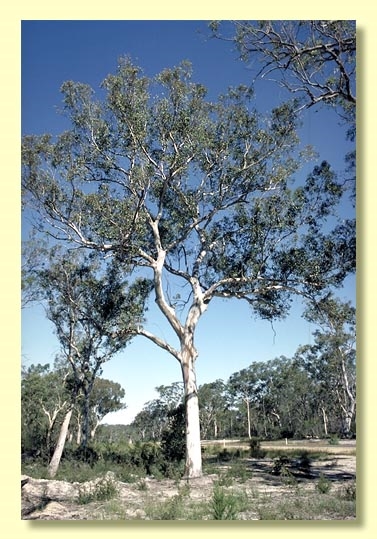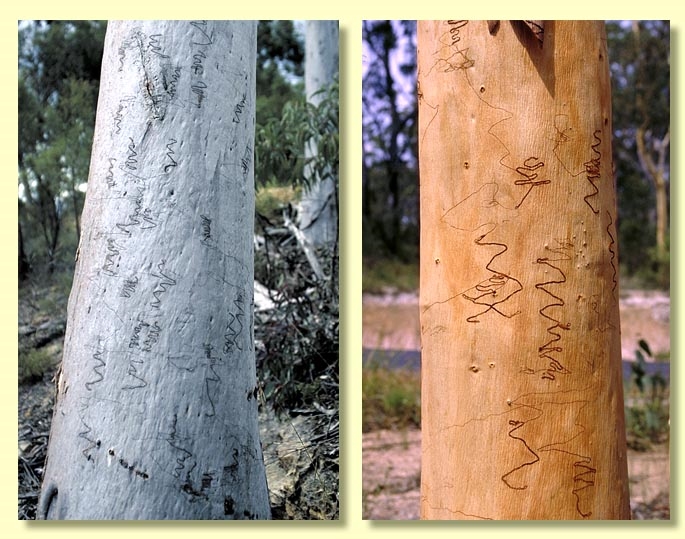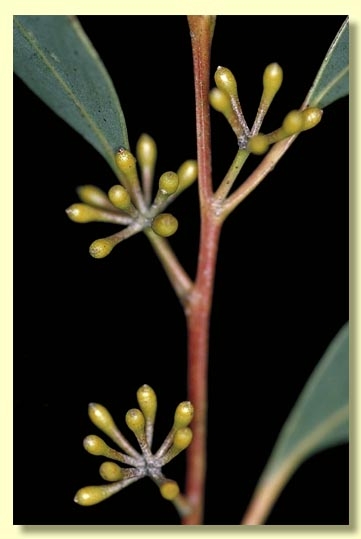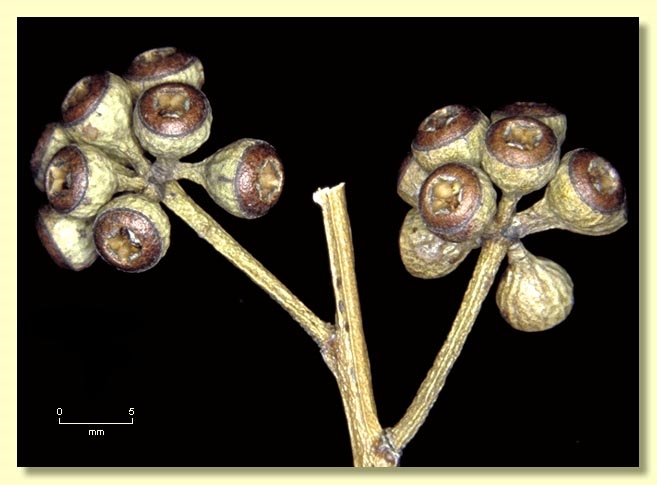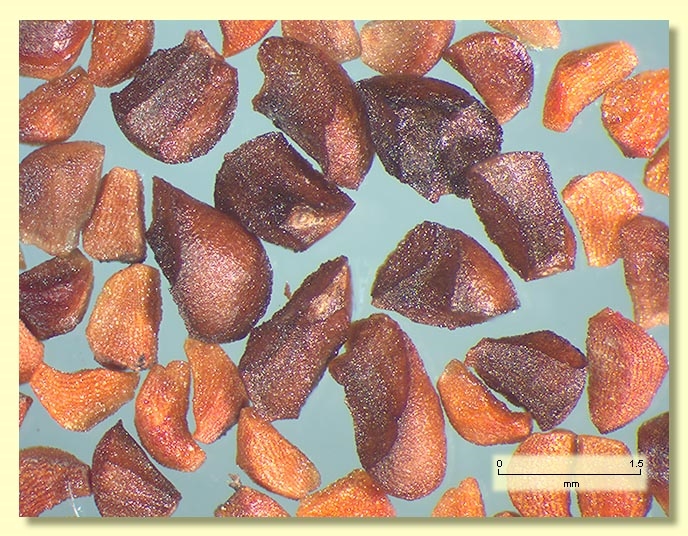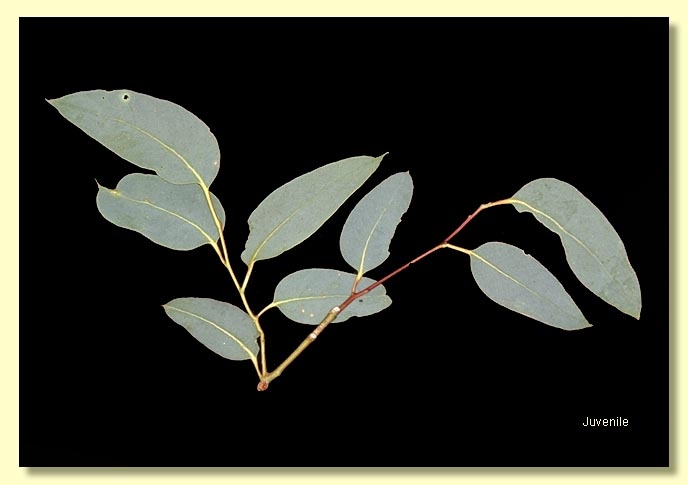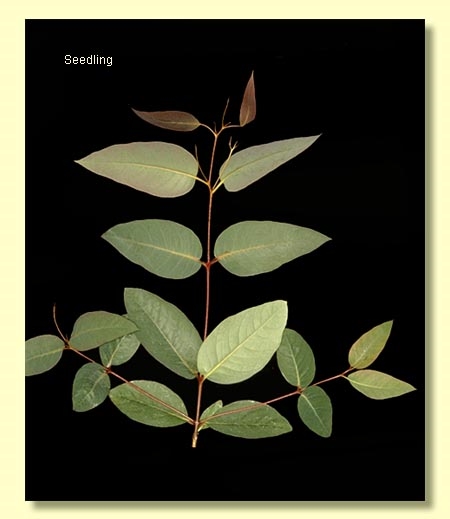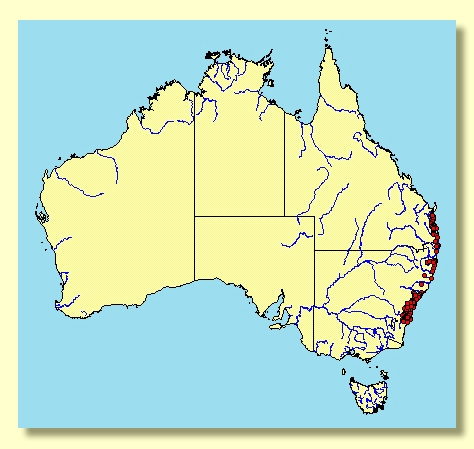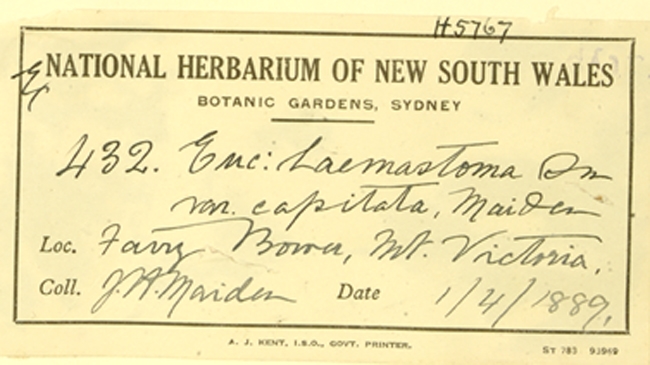Euclid - Online edition
Eucalyptus racemosa subsp. racemosa
Eucalyptus | Eucalyptus | Cineraceae | Psathyroxylon | Haemastomae
T: Botany Bay, NSW, 1793, L.Née s.n.; holo: MA.
Eucalyptus micrantha DC., Prodr. 3: 217 (1828); E. haemastoma var. micrantha (DC.) Benth., Flora Australiensis 3: 212 (1867). T: Australia, 1823, F.W.Sieber 497; holo: G; iso: G, W.
Eucalyptus signata F.Muell., J. Linn. Soc., Bot. 3: 85 (1859); E. micrantha var. signata (F.Muell.) Blakely, Key Eucalypts 219 (1934); E. racemosa var. signata (F. Muell.) R.D.Johnston & Marryatt, in Comm. For. Timber Bur. Leaflet 92: 20 (1965). T: Brisbane R., Qld., F.Mueller s.n.; holo: MEL; iso: K.
Bark smooth, often powdery, mottled grey, white, yellow, cream or pale orange, with scribbles.
Juvenile growth (coppice or field seedlings to 50 cm): stem rounded in cross-section; juvenile leaves shortly petiolate, ovate-elliptic, opposite for 3 to 6 nodes then alternate, ovate to falcate, 5–17 cm long, 2.5–8.5 cm wide, base rounded or tapering obliquely to petiole, dull, blue-green to green.
Adult leaves alternate, petiole 1–2.5 cm long; blade lanceolate to falcate or ovate, 6.5–20(22) cm long, 1–3.5 cm wide, base oblique or tapering to petiole, concolorous, usually glossy, green, side-veins at an acute or wider angle to midrib, sparsely reticulate, intramarginal vein parallel to and well removed from margin, oil glands mostly island.
Inflorescence usually axillary unbranched, sometimes terminal compound, slender peduncles 0.5–2.5 cm long, buds 7 to 15 per umbel, pedicels 0.3–0.6 cm long. Mature buds obovoid, 0.3–0.5 cm long, 0.2–0.3 cm wide, green to yellow, smooth, scar absent, operculum rounded to conical or sometimes beaked, stamens inflexed, usually with a few outer staminodes, anthers reniform to cordate, versatile, dorsifixed, dehiscing by confluent slits, style usually short, stigma tapered, locules 3 or 4, the placentae each with 2 vertical ovule rows. Flowers white.
Fruit pedicels 0.1–0.5 cm long, cup-shaped, obconical or hemispherical, 0.3–0.6 cm long, 0.4–0.7 cm wide, disc raised-convex or annular to level, reddish brown, valves 3 or 4, near rim level.
Seeds brown or reddish brown, 1.2–2 mm long, pyramidal or obliquely pyramidal, dorsal surface smooth, hilum terminal.
Cultivated seedlings (measured at ca node 10): cotyledons reniform to orbicular; stems rounded in cross-section, warty or smooth; leaves sessile to shortly petiolate, ovate-elliptic and opposite for 5 or 6 nodes then alternate, and conspicuously petiolate, ovate, 5–13 cm long, 2.5–6.2 cm wide, base truncate to rounded, later becoming slightly oblique, margin entire, apex pointed, dull, grey-green to green.
Flowering has been recorded in January, February, July, August and September.
Eucalyptus racemosa is a species of small to medium-sized trees widespread in New South Wales from Jervis Bay to Albury and north through coast, tableland and western slope regions to Gympie and Bundaberg in south-eastern Queensland. Eucalyptus racemosa has completely smooth bark whitish becoming yellow in late spring when old bark is shed, glossy or dull adult leaves with sparsely reticulate venation and small buds arranged either in the axils of leaves or terminal to the branchlet. The smooth bark usually has conspicuous scribble marks left by larvae of moths of the genus Ogmograptis.
Eucalyptus racemosa is one of two completely and uniformly smooth-barked scribbly-gum species, the other being the New South Wales endemic species, E. haemastoma of the Central Coast. Eucalyptus racemosa differs from E. haemastoma in having fruit 0.3–0.6 cm wide, whilst the latter has fruit 0.7–1.1 cm wide.
There are two subspecies:
E. racemosa subsp. racemosa
Has a more coastal distribution from Nowra, New South Wales, north to near Bundaberg in Queensland. It has broader juvenile leaves, but with some overlap in dimensions; adult leaves generally less than 7.5 times as long as wide.
E. racemosa subsp. rossii
Occurs on the Tablelands and Western Slopes of New South Wales from Bombala and near Albury north to Pilliga, Warialda and Tenterfield, not quite into Queensland, nor into Victoria. It has narrower juvenile leaves, but with some overlap in dimensions; adult leaves usually more than 7 times as long as wide.
The small fruited white gum Eucalyptus mannifera subsp. mannifera often grows with and can be confused with E. racemosa subsp. rossii but the two differ in the following field characters that are easily assessed: E. mannifera subsp. mannifera has adult leaves with moderate to dense leaf venation and lacks scribbles on the bark contrasting with E. racemosa subsp. rossii which has sparse leaf venation and scribbly bark.
In the classification of Brooker (2000) Eucalyptus racemosa belongs in Eucalyptus subgenus Eucalyptus section Cineraceae series Psathyroxylon having the following characters: cotyledons reniform, juvenile leaves alternate, bluish, adult leaves with side-veins acute, single axillary inflorescences with buds in clusters of seven to 15, buds with single operculum, inflexed stamens, some outer stamens without anthers (staminodes), the remainder with reniform anthers, style short, ovules in two rows, and seeds more or less pyramidal. Within series Psathyroxylon the two scribbly gums E. haemastoma and E. racemosa form subseries Haemastomae.
We include two other species that have been in recent usage, E. sclerophylla and E. signata, in synonymy with E. racemosa as the distinctions are more or less negligible. This view is shared by Bean (1997) and Pfeil & Henwood (2004).

